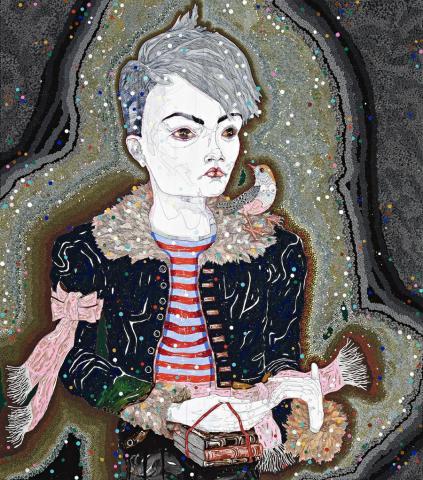BUT PASSION HAS MADE HIS FACE LIKE PALE IVORY, 2011-12
DEL KATHRYN BARTON
synthetic polymer paint, gouache, watercolour and ink on polyester canvas
170.0 x 150.0 cm
signed lower centre: – del kathryn barton –
signed, dated and inscribed verso: del kathryn barton / 2012 / acrylic, gouache, watercolour and / ink on polyester canvas / title / but passion has made his face / like pale ivory
Roslyn Oxley9 Gallery, Sydney (label attached verso)
Private collection, Sydney
del kathryn barton: the nightingale and the rose, Heide Museum of Modern Art, Melbourne, 10 November – 9 December 2012
del kathryn barton: the nightingale and the rose and new work, Newcastle Art Gallery, New South Wales, 15 December 2012 – 17 February 2013 (label attached verso)
Barton, D.K., Oscar Wilde's The nightingale and the rose, Art and Australia, Sydney, 2012, pp. IX – XI, LI, (illus. pp. IX, X, XI)
Ewington, J., DEL KATHRYN BARTON, Piper Press, Sydney, 2014, pp. 73, 74 (illus. p. 74)
The delicate linear qualities and exuberant patterning at the heart of Del Kathryn Barton's practice combine in but passion has made his face like pale ivory, 2011-12. The artist's drawn lines articulate the male subject's facial planes like a tender topographical map. This intimate rendering of every minor shadow is charged with the romantic and passionate connotations of lingering observation. An intimacy that is accentuated by the concentrated gaze of the subject's own eyes and the nearly pointillist force field that encircles him.
Male figures rarely appear in Barton's paintings and here there is a particular resonance, for the boy is the student from Oscar Wilde's The Nightingale and the Rose, 1888. With the student 'sorrow has set her seal upon his brow.'1 This spurs the nightingale, as selfless heroine, to seek out a red rose to enable the student's love to flourish. The fairy tale aspect within Barton's work is exacerbated by the motif of Wilde's fable where elaborate confection collapses in to a darker sacrificial realm. 'Only a Nightingale's heart's-blood can crimson the heart of a rose.'2
The pale skin of the love-struck student appears both paper-thin and heavy as marble, echoing the force and fickleness of passion and the eerie distillation of corporeal realities within the mythic realm. Throughout the artist's wider practice, the perils of enchantment are similarly addressed; 'the whole that is everything, this consuming whole of pleasure, is as fatal as it is fertile, as voiding and emetic as it is fulfilling'.3
Wilde's text and Barton's paintings of The Nightingale and the Rose were brought together in a lavish hardcopy book published in 2012 by Art and Australia. Across the pages, Barton's suite of twenty paintings and drawings embody the unabashed intensity of the classic tale. The importance of our present offering within the series is highlighted by the commanding presence it holds in this publication.
Barton's intense and intricate approach to painting has made her a leading Australian figurative artist. This has led to inclusion in significant institutional and private collections including Art Gallery of New South Wales, Sydney; National Gallery of Australia, Canberra; Museum of Old and New Art, Hobart; Artbank; and the BHP Billiton Collection, Melbourne. Notably, Barton was twice awarded the prestigious Archibald Prize, in 2008 and again in 2013.
1. Wilde, O., The Nightingale and the Rose, 1888, in Barton, D.K., Oscar Wilde, The Nightingale and the Rose, Dott Publishing, Art and Australia Pty Ltd, 2012, p. 4
2. Ibid., p. 36
3. Colless, E., 'Eden and After', in The Whole of Everything, Karen Woodbury Gallery, Melbourne, 2008, p. 35
AMY MARJORAM
